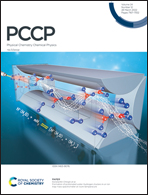A transition from solid effect to indirect cross effect with broadband microwave irradiation†
Abstract
Dynamic nuclear polarization (DNP) at high magnetic fields has become a prominent technique for signal enhancement in nuclear magnetic resonance (NMR). In static samples, the highest DNP enhancement is usually observed for high radical concentrations in the range of 15–40 mM. Under these conditions, the dominant DNP mechanism for broad-line radicals is the electron–electron spectral-diffusion-based indirect cross effect (iCE). To further increase the DNP performance, broadband microwave irradiation is often applied. Until now, the theory of iCE was not rigorously combined with broadband microwave irradiation. This paper fills this gap by extending the iCE theory to explicitly include broadband irradiation. We demonstrate that our theory allows for quantitative fitting of the DNP spectra lineshapes using four different datasets acquired at 3.4 T and 7 T. We find that the DNP mechanism changes with an increase in the excitation bandwidth. While with narrowband continuous-wave irradiation the DNP mechanism is a combination of the solid effect (SE) and iCE, it shifts toward iCE with increasing excitation bandwidth until, at high bandwidth, the iCE completely dominates the DNP spectrum – this effect was not accounted for previously.



 Please wait while we load your content...
Please wait while we load your content...